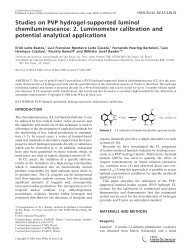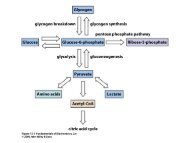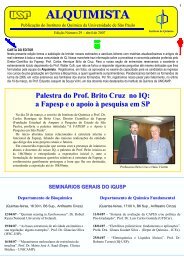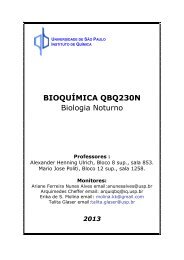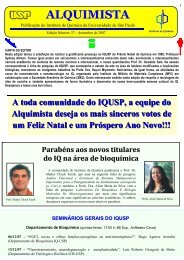The development of strategies for terpenoid structure determination
The development of strategies for terpenoid structure determination
The development of strategies for terpenoid structure determination
Create successful ePaper yourself
Turn your PDF publications into a flip-book with our unique Google optimized e-Paper software.
naturally occurring tumour promoting phorbol esters exemplifiedby resiniferatoxin 78. 129<strong>The</strong> <strong>development</strong> <strong>of</strong> chloroquine resistant strains <strong>of</strong> themalaria parasite, Plasmodium falciparum, led to the search <strong>for</strong>novel antimalarials and to the isolation <strong>of</strong> an unusual sesqui<strong>terpenoid</strong>cyclic peroxyketal (qinghaosu) from Artemisia annua.<strong>The</strong> <strong>structure</strong>s <strong>of</strong> this compound and its relatives were establishedby a combination <strong>of</strong> X-ray crystallography and NMRmethods. 13019 Strategies based on 2D NMR correlationsIn the mid 1980’s <strong>strategies</strong> based on two dimensional NMRcorrelations began to be developed. <strong>The</strong>se included two dimensional1 H– 1 H and 13 C– 1 H COSY spectra. An early application<strong>of</strong> 2D 13 C– 1 H spectroscopy may be found in the assignment <strong>of</strong>the <strong>structure</strong> <strong>of</strong> an insecticidal di<strong>terpenoid</strong>, 9,21-didehydroryanodine79 from Ryania speciosa. 131 Another example <strong>of</strong> twodimensional long range 13 C– 1 H correlations was their use in theinterrelationship <strong>of</strong> the 1 H signals from the methyl groups <strong>of</strong>esters <strong>of</strong> 19-hydroxyingol esters 80 from Euphorbia poisonii. 132Whilst these methods led to the recognition <strong>of</strong> specificarrangements <strong>of</strong> atoms with characteristic NMR chemicalshifts, multiplicities and integrals, the application <strong>of</strong> twodimensionalNMR methods 133 to the assembly <strong>of</strong> fragmentsinvolved the <strong>development</strong> <strong>of</strong> heteronuclear multiple bondcorrelations (HMBC). A typical strategy using 2D NMR data,is to link the 1 H and 13 C resonances via a heteroCOSY experimentand then to establish the 1 H– 1 H correlations by a homonuclearCOSY experiment. From these correlations it is thenpossible to infer the C–C connectivities and to begin to establishpart <strong>structure</strong>s. When the part <strong>structure</strong>s are terminated bya quaternary centre, it may then be possible to establish longrange connectivities using an HMBC spectrum. A planar<strong>structure</strong> may be derived this way. <strong>The</strong> relative stereochemistrymay then be ascertained by 2D nuclear Overhauser exchangespectroscopy (NOESY) or by the measurement <strong>of</strong> proton couplingconstants. <strong>The</strong> absolute stereochemistry may be assignedeither by chiroptical methods or by using an NMR methodbased on derivatization with a chiral reagent. Over the last tenyears there have been very many examples <strong>of</strong> this strategy usingtwo dimensional techniques particularly in the elucidation <strong>of</strong>the <strong>structure</strong>s <strong>of</strong> di<strong>terpenoid</strong>s from marine sources and in thesearch <strong>for</strong> novel taxanes.One example is the elucidation <strong>of</strong> the <strong>structure</strong> <strong>of</strong> theorthosiphols A 81 and B which are di<strong>terpenoid</strong> antiinflammatoryagents from the medicinal herb Orthosiphon stamineus. 134<strong>The</strong> planar <strong>structure</strong> was identified by the use <strong>of</strong> 1 H– 1 H and13 C– 1 H COSY correlations and the relative stereochemistryfrom the NOESY spectrum. <strong>The</strong> chirality was established bythe exciton chirality method based on the interaction betweenthe benzoate groups. <strong>The</strong>re are also many examples <strong>of</strong> thisstrategy in the studies on the chemistry <strong>of</strong> marine organisms.One example is that <strong>of</strong> sarcoglane 82, a cytotoxic diterpeneobtained from the coral Sarcophyton glaucum. 135 <strong>The</strong> EIMS, IRand one dimensional NMR spectra revealed the nature <strong>of</strong>the functionality whilst 2D NMR spectra (COSY) suggestedthe presence <strong>of</strong> the two substantial fragments shown in 83. <strong>The</strong>connectivities between these partial <strong>structure</strong>s were establishedby the C–H correlations in the HMBC spectrum to give theplanar <strong>structure</strong>. <strong>The</strong> relative stereochemistry and in particularthe geometry <strong>of</strong> the ring junctions was assigned on the basis <strong>of</strong>NOE experiments. <strong>The</strong> liverworts have been the source <strong>of</strong> manyinteresting <strong>terpenoid</strong>s. In the <strong>structure</strong> <strong>of</strong> hatcherone 84 from aliverwort, Barbophozia hatcheri, the 1 H– 1 H and 1 H detectedheteronuclear multiple quantum coherence (HMQC) spectrumestablished 136 the presence <strong>of</strong> the units shown in 85. <strong>The</strong> connectivity<strong>of</strong> these units was clarified by the HMBC spectrumand the relative stereochemistry was established by nuclearOverhauser spectroscopy. <strong>The</strong> branched chain nature <strong>of</strong> theisoprene unit lends itself to these studies. Thus in theseexamples the angular methyl groups lying within the heart <strong>of</strong>the molecule possess useful transannular interactions. <strong>The</strong>absolute stereochemistry <strong>of</strong> hatcherone was established by theapplication <strong>of</strong> the octant rule to the sign <strong>of</strong> the Cotton effect inthe CD spectrum.When another marine di<strong>terpenoid</strong> natural product, eleutherobin86, with a similar activity to that <strong>of</strong> Taxol but with acompletely different <strong>structure</strong>, was discovered 137 in 1997, the<strong>structure</strong> elucidation was completely dominated by the use <strong>of</strong>two dimensional homo- and heteronuclear correlation spectra.<strong>The</strong> <strong>structure</strong> <strong>determination</strong> <strong>of</strong> many marine natural productsfollows this strategy.Nat. Prod. Rep., 2001, 18, 607–617 615



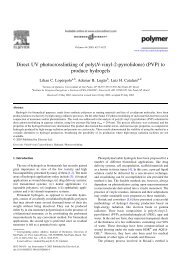
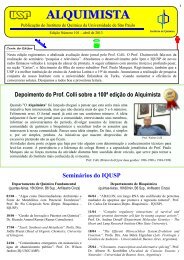
![PE]+ + N. Fragmentação por clivagem sigma](https://img.yumpu.com/50134385/1/180x260/pe-n-fragmentaaao-por-clivagem-sigma.jpg?quality=85)
